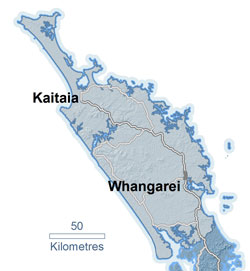Climate change projections for the Northland region
This page provides an overview of how the climate in the Northland region is likely to change into the future and what implications this has for the region.
This page provides an overview of how the climate in the Northland region is likely to change into the future and what implications this has for the region.

Projections of climate change depend on future greenhouse gas emissions, which are uncertain. There are four main global emissions scenarios ranging from low to high greenhouse gas concentrations. This page presents regional projections as a range of values from a low emissions to a high emissions future.
The projected changes are calculated for 2031–2050 (referred to as 2040) and 2081–2100 (2090) compared to the climate of 1986–2005 (1995).
Compared to 1995, temperatures are likely to be 0.7˚C to 1.1˚C warmer by 2040 and 0.7˚C to 3.1˚C warmer by 2090.
By 2090, Northland is projected to have from 13 to 75 extra days per year where maximum temperatures exceed 25˚C. The Far North already experiences very few frosts and in the future frosts are likely to become extremely rare.
Rainfall will vary locally within each region. The largest changes will be for particular seasons rather than annually.
Seasonal projections show spring rainfall decreasing by 1 to 12 per cent in Kaitaia and 3 to 17 per cent in Whangarei by 2090.
There is large natural variability in extreme rainfall frequency in Northland from year to year and decade to decade. According to the most recent projections, Northland is not expected to experience a significant change in the frequency of extreme rainy days as a result of climate change. In fact it is likely to experience a decrease in daily extreme rainfall by 2090 under the highest emissions scenario.
The frequency of extremely windy days in Northland by 2090 is likely to decrease by up to 5 per cent. There may be an increase in westerly wind flow during winter and north-easterly wind flow during summer.
Future changes in the frequency of storms are likely to be small compared to natural inter-annual variability. Some increase in storm intensity, local wind extremes and thunderstorms is likely to occur.
The frequency of ex-tropical cyclones is projected to either decrease or remain unchanged over the 21st century; however the ex-tropical cyclones will likely be stronger and cause more damage as a result of heavy rain and strong winds.
New Zealand tide records show an average rise in relative mean sea level of 1.7 mm per year over the 20th century. Globally, the rate of rise has increased, and further rise is expected in the future.
The Ministry for the Environment provides guidance on coastal hazards and climate change, including recommendations for sea level rise.
See Preparing for coastal change: A summary of coastal hazards and climate change guidance for local government. The guidance was updated in December 2017.
By 2090, the region could expect*:
| Spring |
|
|---|---|
| Summer |
|
| Autumn |
|
| Winter |
|
*Projected changes are relative to 1995 levels. The values provided capture the range across all scenarios. They are based on scenario estimates and should not be taken as definitive. For more information, see the full report on climate projections.
Coastal roads and infrastructure may face increased risk from coastal erosion and inundation, increased storminess and sea-level rise.
By 2090, the time spent in drought ranges from minimal change through to more than double, depending on the climate model and emissions scenario considered. More frequent droughts are likely to lead to water shortages, increased demand for irrigation and increased risk of wild fires. Droughts are likely to increase in both intensity and duration.
There may be an increase in the occurrence of summer water-borne and food-borne diseases such as Salmonella. There could also be an increased risk from some vector-borne diseases such as Dengue Fever and the Ross River Virus.
Climate change could result in an increased incidence of invasive pests affecting both pasture and horticultural crops. Several existing pest species could become more serious pests with even a slight increase in temperature.
Production of some crops (such as kiwi fruit) is likely to become uneconomic in Northland by 2050 because of a lack of winter chilling. Warmer temperatures, a longer growing season, and frosts becoming rare could provide opportunities to grow new sub-tropical crops. Farmers might benefit from faster growth of pasture and better crop growing conditions. However, these benefits may be limited by negative effects of climate change such as prolonged drought, increased flood risk and greater frequency and intensity of storms.
The Ministry for Primary Industries website and associated Climate Cloud website have more information on the regional impacts of climate change on agriculture.
Northland Regional Council’s climate change information [Northland Regional Council website]